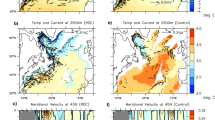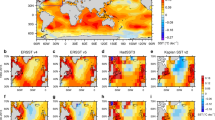Abstract
Seasonal and interannual variations of the equatorial cold tongue are defining features of the tropical Atlantic Ocean, with significant climatic1,2,3 and biogeochemical4 effects. However, its long-term changes are poorly understood owing to biases in observations and climate models5. Here we use a suite of bias-corrected observations, and find that cold-tongue variability has weakened during the past six decades. We find that sea surface temperature has increased across the basin, with a local enhancement over the eastern equatorial Atlantic. This warming pattern of the sea surface is most pronounced during boreal summer, reducing the annual cycle through a positive ocean–atmosphere feedback. Specifically, the eastward-intensified warming leads to enhanced atmospheric convection in the equatorial eastern Atlantic region, as well as to less vigorous trade winds. These in turn deepen the thermocline in the east, and reinforce the sea surface warming pattern. The flattened thermocline and reduced thermocline feedback weaken interannual variability of equatorial sea surface temperatures and Guinea coast precipitation associated with the Atlantic Niño. We suggest that the observed changes could be associated with cooling by anthropogenic aerosols, an effect that is stronger in the Northern than in the Southern Hemisphere. If the aerosol emissions decrease in the next decades, the tropical Atlantic may experience yet another shift as the greenhouse gas forcing increases.
This is a preview of subscription content, access via your institution
Access options
Subscribe to this journal
Receive 12 print issues and online access
$259.00 per year
only $21.58 per issue
Buy this article
- Purchase on Springer Link
- Instant access to full article PDF
Prices may be subject to local taxes which are calculated during checkout




Similar content being viewed by others
References
Carton, J. A., Cao, X. H., Giese, B. S. & daSilva, A. M. Decadal and interannual SST variability in the tropical Atlantic Ocean. J. Phys. Oceanogr. 26, 1165–1175 (1996).
Hirst, A. C. & Hastenrath, S. Atmosphere–ocean mechanisms of climate anomalies in the Angola-tropical Atlantic sector. J. Phys. Oceanogr. 13, 1146–1157 (1983).
Ruiz-Barradas, A., Carton, J. A. & Nigam, S. Structure of interannual-to-decadal climate variability in the tropical Atlantic sector. J. Clim. 13, 3285–3297 (2000).
Boyd, A. J., Tauntonclark, J. & Oberholster, G. P. J. Spatial features of the near-surface and midwater circulation patterns off western and southern South Africa and their role in the life histories of various commercially fished species. S. Afr. J. Mar. Sci. 12, 189–206 (1992).
Richter, I. & Xie, S-P. On the origin of equatorial Atlantic biases in coupled general circulation models. Clim. Dyn. 31, 587–598 (2008).
Xie, S-P. et al. Global warming pattern formation: Sea surface temperature and rainfall. J. Clim. 23, 966–986 (2010).
Clement, A. C., Baker, A. C. & Leloup, J. Climate change: Patterns of tropical warming. Nature Geosci. 3, 8–9 (2010).
Vecchi, G. A. et al. Weakening of tropical Pacific atmospheric circulation due to anthropogenic forcing. Nature 441, 73–76 (2006).
Vecchi, G. A., Clement, A. & Soden, B. J. Examining the tropical Pacific’s response to global warming. Eos Trans. AGU 89, 81 (2008).
Han, W. et al. Patterns of Indian Ocean sea-level change in a warming climate. Nature Geosci. 3, 509–584 (2010).
Zheng, X. T., Xie, S-P., Vecchi, G. A., Liu, Q. Y. & Hafner, J. Indian Ocean dipole response to global warming: Analysis of ocean-atmospheric feedbacks in a coupled model. J. Clim. 23, 1240–1253 (2010).
Abram, N. J., Gagan, M. K., Cole, J. E., Hantoro, W. S. & Mudelsee, M. Recent intensification of tropical climate variability in the Indian Ocean. Nature Geosci. 1, 849–853 (2008).
Sen, P. K. Estimates of the regression coefficient based on Kendall’s tau. J. Am. Stat. Assoc. 63, 1379–1389 (1968).
Zebiak, S. E. Air–sea interaction in the equatorial Atlantic region. J. Clim. 6, 1567–1568 (1993).
Tokinaga, H. & Xie, S-P. Wave- and Anemometer-based Sea-surface Wind (WASWind) for climate change analysis. J. Clim. 24, 267–285 (2011).
Chang, P. et al. Oceanic link between abrupt changes in the North Atlantic Ocean and the African monsoon. Nature Geosci. 1, 444–448 (2008).
Bryden, H. L., Longworth, H. R. & Cunningham, S. A. Slowing of the Atlantic meridional overturning circulation at 25° N. Nature 438, 655–657 (2005).
Wang, C. Z., Dong, S. F. & Munoz, E. Seawater density variations in the North Atlantic and the Atlantic meridional overturning circulation. Clim. Dyn. 34, 953–968 (2010).
Enfield, D. B., Mestas-Nunez, A. M. & Trimble, P. J. The Atlantic multidecadal oscillation and its relation to rainfall and river flows in the continental US. Geophys. Res. Lett. 28, 2077–2080 (2001).
Chang, C-Y. et al. Sulfate aerosol control of tropical Atlantic climate over the 20th century. J. Clim. 10.1175/2010JCLI4065.1 (2011, in the press).
Philander, S. G. H. & Pacanowski, R. C. A model of the seasonal cycle in the tropical Atlantic Ocean. J. Geophys. Res. 91, 14192–14206 (1986).
Giannini, A., Saravanan, R. & Chang, P. Oceanic forcing of Sahel rainfall on interannual to interdecadal time scales. Science 302, 1027–1030 (2003).
Kawase, H. et al. Physical mechanism of long-term drying trend over tropical North Africa. Geophys. Res. Lett. 37, L09706 (2010).
Bjerknes, J. Atmospheric teleconnections from the equatorial Pacific. Mon. Weath. Rev. 97, 163–172 (1969).
Kendall, M. G. Rank Correlation Methods (Griffin, 1975).
Woodruff, S. D. et al. ICOADS Release 2.5: Extensions and enhancements to the surface marine meteorological archive. Int. J. Climatol. 10.1002/joc.2103 (2010).
Norris, J. R. Trends in upper-level cloud cover and surface divergence over the tropical Indo-Pacific Ocean between 1952 and 1997. J. Geophys. Res. 110, D21110 (2005).
Deser, C. & Phillips, A. S. Simulation of the 1976/77 climate transition over the North Pacific: Sensitivity to tropical forcing. J. Clim. 19, 6170–6180 (2006).
Wijffels, S. E. et al. Changing expendable bathythermograph fall rates and their impact on estimates of thermosteric sea level rise. J. Clim. 21, 5657–5672 (2008).
Willmott, C. J. & Robeson, S. M. Climatologically aided interpolation (CAI) of terrestrial air temperature. Int. J. Climatol. 15, 221–229 (1995).
Acknowledgements
The work was supported by NOAA, NSF, NASA and JAMSTEC. We thank T. Ogata for conducting the ocean GCM hindcast.
Author information
Authors and Affiliations
Contributions
H.T. and S-P.X. contributed to the central ideas presented in the paper. H.T. compiled and analysed ship observations. H.T. and S-P.X. wrote the paper.
Corresponding author
Ethics declarations
Competing interests
The authors declare no competing financial interests.
Supplementary information
Supplementary Information
Supplementary Information (PDF 1456 kb)
Rights and permissions
About this article
Cite this article
Tokinaga, H., Xie, SP. Weakening of the equatorial Atlantic cold tongue over the past six decades. Nature Geosci 4, 222–226 (2011). https://doi.org/10.1038/ngeo1078
Received:
Accepted:
Published:
Issue Date:
DOI: https://doi.org/10.1038/ngeo1078
This article is cited by
-
Future weakening of southeastern tropical Atlantic Ocean interannual sea surface temperature variability in a global climate model
Climate Dynamics (2023)
-
Weakened interannual Tropical Atlantic variability in CMIP6 historical simulations
Climate Dynamics (2023)
-
Suppressed Atlantic Niño/Niña variability under greenhouse warming
Nature Climate Change (2022)
-
Weakening of the Atlantic Niño variability under global warming
Nature Climate Change (2022)
-
Changing variability of sea surface temperature in the post-WWII era
Journal of Earth System Science (2021)



